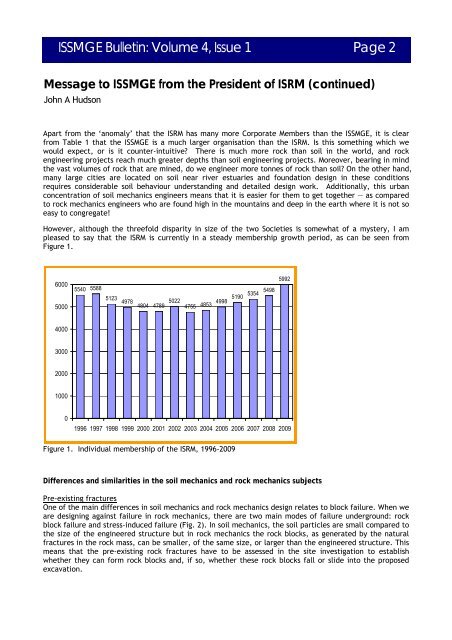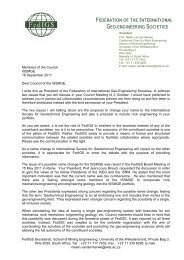Vol. 4, Issue 1, March 2010 - Australian Geomechanics Society
Vol. 4, Issue 1, March 2010 - Australian Geomechanics Society
Vol. 4, Issue 1, March 2010 - Australian Geomechanics Society
Create successful ePaper yourself
Turn your PDF publications into a flip-book with our unique Google optimized e-Paper software.
ISSMGE Bulletin: <strong>Vol</strong>ume 4, <strong>Issue</strong> 1 Page 2<br />
Message to ISSMGE from the President of ISRM (continued)<br />
John A Hudson<br />
Apart from the ‘anomaly’ that the ISRM has many more Corporate Members than the ISSMGE, it is clear<br />
from Table 1 that the ISSMGE is a much larger organisation than the ISRM. Is this something which we<br />
would expect, or is it counter-intuitive There is much more rock than soil in the world, and rock<br />
engineering projects reach much greater depths than soil engineering projects. Moreover, bearing in mind<br />
the vast volumes of rock that are mined, do we engineer more tonnes of rock than soil On the other hand,<br />
many large cities are located on soil near river estuaries and foundation design in these conditions<br />
requires considerable soil behaviour understanding and detailed design work. Additionally, this urban<br />
concentration of soil mechanics engineers means that it is easier for them to get together — as compared<br />
to rock mechanics engineers who are found high in the mountains and deep in the earth where it is not so<br />
easy to congregate!<br />
However, although the threefold disparity in size of the two Societies is somewhat of a mystery, I am<br />
pleased to say that the ISRM is currently in a steady membership growth period, as can be seen from<br />
Figure 1.<br />
6000<br />
5000<br />
5540 5588<br />
5123 4978 4804 4789<br />
5022<br />
4755 4853 4998 5190 5354 5498 5992<br />
4000<br />
3000<br />
2000<br />
1000<br />
0<br />
1996 1997 1998 1999 2000 2001 2002 2003 2004 2005 2006 2007 2008 2009<br />
Figure 1. Individual membership of the ISRM, 1996-2009<br />
Differences and similarities in the soil mechanics and rock mechanics subjects<br />
Pre-existing fractures<br />
One of the main differences in soil mechanics and rock mechanics design relates to block failure. When we<br />
are designing against failure in rock mechanics, there are two main modes of failure underground: rock<br />
block failure and stress-induced failure (Fig. 2). In soil mechanics, the soil particles are small compared to<br />
the size of the engineered structure but in rock mechanics the rock blocks, as generated by the natural<br />
fractures in the rock mass, can be smaller, of the same size, or larger than the engineered structure. This<br />
means that the pre-existing rock fractures have to be assessed in the site investigation to establish<br />
whether they can form rock blocks and, if so, whether these rock blocks fall or slide into the proposed<br />
excavation.




